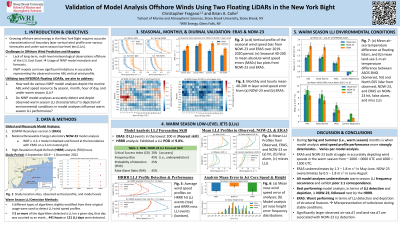Back

Offshore Wind Power Science
Validation of Model Analysis Offshore Winds Using Two Floating LiDARs in the New York Bight
Tuesday, October 29, 2024
12:30 PM – 12:40 PM ET


Christopher Fragano, M.S.
Meteorologist
WRI Energy, New York
Presenter(s)
Presentation Description: Use of model reanalyses for wind power resource assessments can result in considerable wind errors, especially when low-level jets (LLJs) occur, which are an important warm season coastal wind in the New York Bight (NYB). This study uses approximately three years (September 2019 - December 2022) of hourly vertical wind profiler data from two New York State Energy Research and Development Authority floating lidars in the NYB, as well as the ERA5 reanalysis, NREL’s NOW-23 WRF, and the HRRR model analysis. The goal is to understand how well these model winds compare against observations in the lowest 200 m ASL for the spring and summer months and on warm season LLJ events.
Our study reveals that the warm season is when both ERA5 and NOW-23 struggle in accurately depicting the wind speed resource characteristics, with NOW-23 significantly outperforming the ERA5 in terms of 20 – 200 m layer wind speed bias. ERA5 and NOW-23 significantly differ in the sign of and temporal nature of wind speed errors. During warm season LLJ events, the ERA5 was found to have the poorest performance in terms of LLJ detection (zero hours detected) and depiction of LLJ structural features. The NOW-23 performed most accurately out of all the model analyses in terms of LLJ detection and performance metrics. On average, the lidar observed LLJ profile had a jet nose maximum of 11.2 ± 0.4 m/s at 100 m. All model analyses underestimate the jet core wind speeds and overestimate jet core heights. NOW-23 exhibits smallest jet core speed and height errors at -1.06 m/s and ~ 25 m. The ERA5 and HRRR analysis perform significantly similar with large average core speed underestimations of 2.6 – 2.8 m/s and core height overestimation of ~ 45 m.
Our study reveals that the warm season is when both ERA5 and NOW-23 struggle in accurately depicting the wind speed resource characteristics, with NOW-23 significantly outperforming the ERA5 in terms of 20 – 200 m layer wind speed bias. ERA5 and NOW-23 significantly differ in the sign of and temporal nature of wind speed errors. During warm season LLJ events, the ERA5 was found to have the poorest performance in terms of LLJ detection (zero hours detected) and depiction of LLJ structural features. The NOW-23 performed most accurately out of all the model analyses in terms of LLJ detection and performance metrics. On average, the lidar observed LLJ profile had a jet nose maximum of 11.2 ± 0.4 m/s at 100 m. All model analyses underestimate the jet core wind speeds and overestimate jet core heights. NOW-23 exhibits smallest jet core speed and height errors at -1.06 m/s and ~ 25 m. The ERA5 and HRRR analysis perform significantly similar with large average core speed underestimations of 2.6 – 2.8 m/s and core height overestimation of ~ 45 m.

.png)
.png)